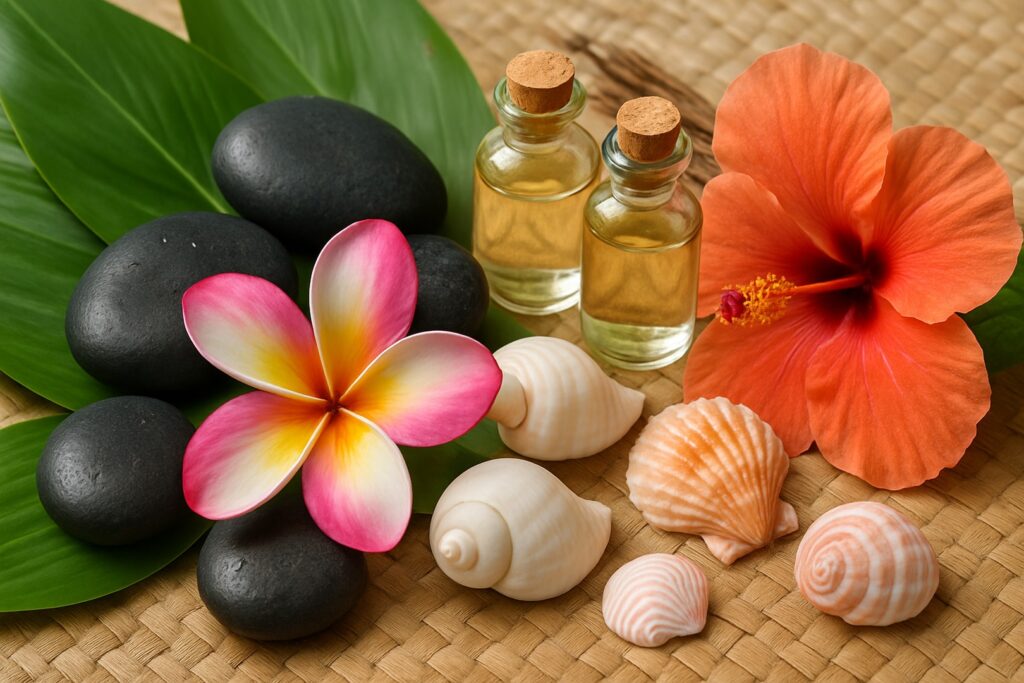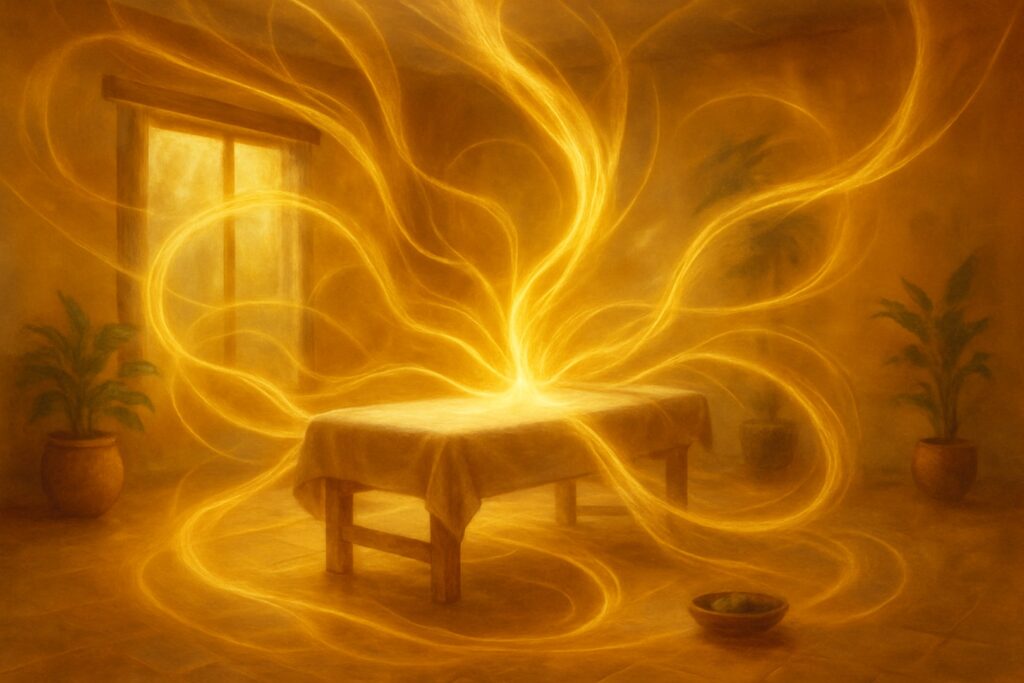The space where massage takes place is much more than just a physical location. It is a temple of transformation where body, mind, and spirit can find harmony. In the Hawaiian tradition, where lomi lomi massage originated, the therapeutic space is an extension of the healer’s intention—a place where energy can flow freely and healing touch achieves its fullest power.
Space as an Extension of Intention
When you enter a room where authentic lomi lomi massage takes place, the first thing you feel is not just the scent of oils or the sound of music—it’s energy. Energy that has been consciously shaped by the therapist to create a field of safety and transformation.
In Hawaiian tradition, therapeutic space is treated as a living organism that participates in the healing process. As emphasized by the Lomilomi Hana Lima school: “Our space is designed to reflect the beauty and serenity of Hawaii, creating the perfect setting for relaxation and healing” [1]. This is not merely a matter of aesthetics—it is a fundamental element of therapeutic effectiveness.
Rituals for Preparing the Space
Before the first client crosses the threshold, the lomi lomi space undergoes a process of cleansing and preparation. Traditionally, kahuna (Hawaiian healers) used seawater, herbs, and prayers to cleanse the energy of the room. Contemporary practitioners continue these traditions, adapting them to today’s realities.
“In lomi lomi, the preparation of both the space and the practitioner is considered essential to the healing process. Traditionally, practitioners engage in rituals to cleanse and bless the area where the massage will take place. This may involve the use of salt water, herbs, and essential oils to purify the space and create an atmosphere of tranquility and healing” [2].
My own ritual for preparing the space always begins with inner silence. Before I invite anyone into my treatment room, I spend time in meditation, connecting with mana energy (life force) and directing healing intention to every corner of the room. Then I use incense made from local herbs to cleanse the space and drops of seawater to bless the four directions.
Elements of Natural Environment

Hawaiians believe that healing comes from nature, which is why an authentic lomi lomi space contains natural elements that remind us of our connection to ‘āina (the land). In a traditional lomi lomi setting, you will find:
- Fresh flowers and plants—especially those of cultural significance, like ti leaf (ki), which are considered sacred and protective
- Volcanic stones—representing stability and connection to the earth
- Shells—symbolizing the ocean and its cleansing energy
- Wooden elements—reminding us of the wisdom of trees and their ability to connect heaven and earth
As noted by Vanessa Zevallos, a lomi practitioner at Kōkua Kalihi Valley: “All of these healing techniques work together to care for the whole person. The commonality between the methods is the connection to ‘āina (land). I’ve seen similar practices in many indigenous cultures” [3].
Sound and Scent as Elements of Space
In Hawaiian tradition, sound and scent are not add-ons—they are integral elements of the therapeutic space that directly influence the healing experience.
Traditionally, lomi lomi sessions were often conducted with the accompaniment of oli (chants) and pule (prayers), which introduced healing vibrations into the space. Today, many practitioners use recordings of traditional Hawaiian instruments, such as ipu (percussion gourd) or ukulele, or sounds of nature—the rush of waves, birdsong, or tropical rain.
Scents also play a key role. Coconut oils, often enriched with local herbs and flowers, not only serve as a medium for touch but fill the space with an aroma that transports the client to the Hawaiian islands. Some practitioners also use incense from local plants, such as koa or sandalwood, to cleanse energy and create an atmosphere of sacredness.
Light and Color in Lomi Lomi Space
Light in a lomi lomi space should mimic natural cycles—soft, warm, and non-aggressive. Traditionally, sessions took place in sunlight filtered through leaves or by moonlight. Today, practitioners often use candles or dimmed, warm light that creates an intimate atmosphere of safety.
Colors in lomi lomi space also have symbolic significance:
- Green—represents the lushness of Hawaiian forests and renewal
- Blue—symbolizes the ocean and fluidity
- Brown and earthy tones—remind us of our connection to the earth
- White—represents purity and light
Temperature and Airflow
Warmth is an integral element of Hawaiian massage. A lomi lomi space should be warm but not hot, allowing the body to completely relax without feeling discomfort. Traditionally, massages took place in Hawaii’s warm climate, where the natural temperature was conducive to muscle relaxation.
Equally important is airflow. A gentle breeze, whether natural or created by a quiet fan, symbolizes the flow of energy and prevents stagnation. In Hawaiian tradition, wind (makani) is considered a carrier of spirit and healing energy.
Space Organization and Energy Flow

The layout of a lomi lomi space should allow free movement for both the therapist and energy. Traditionally, the massage table (or mat) is placed in the center of the room, allowing the therapist access from all sides and enabling the flowing, dance-like movements characteristic of lomi lomi.
“The practitioner uses their entire body as a tool, not just their hands. This includes the use of forearms, elbows, and even feet to apply pressure and create smooth, flowing movements. The practitioner’s body movements are coordinated with their breath, creating a seamless and fluid experience that enhances the connection between the practitioner and the recipient” [2].
The space should be free from unnecessary objects and obstacles that could disrupt this healing dance. At the same time, it should contain places for essential accessories—oils, towels, pillows—all within reach but not visually dominating.
Creating Sacred Space in Everyday Life
Not everyone has the luxury of having a dedicated room for lomi lomi practice. However, even in a limited space, you can create an atmosphere that honors the spirit of this tradition.
The key is intention. As Hawaiian tradition says: “Energy follows attention.” Even the simplest room can become a sacred space when you approach its preparation with full awareness and respect.
Here are some practical tips for those who want to create a lomi lomi space in their home or office:
- Cleanse the space—both physically and energetically. Clean thoroughly, then use incense, sounds (e.g., bells), or your own intention to cleanse the energy.
- Introduce elements of nature—even a single flower, a bowl of stones, or a shell can transform the energy of a space.
- Take care of the senses—soft light, pleasant music, subtle scent—all create a multi-dimensional experience.
- Create an altar or a place to focus intention—this can be a simple shelf with an object symbolizing healing or connection to Hawaiian tradition.
- Maintain energetic boundaries—a lomi lomi space should be protected from the chaotic energies of the outside world. You can use sea salt sprinkled at the entrance or visualize protective light.
Space as a Teacher
In Hawaiian tradition, space is not a passive background—it is an active participant in the healing process and a teacher for both the therapist and the client.
A well-designed lomi lomi space teaches us how to be present, how to breathe more deeply, how to allow ourselves to completely relax and trust. It reminds us of our connection to nature, to ancestors, to wisdom that transcends our everyday experience.
As a Hawaiian saying goes: “Ma ka hana ka ‘ike”—knowledge comes through action. By creating a sacred space for lomi lomi, you are not just preparing a place for massage—you are learning the art of creating a sanctuary that can transform energy, heal the body, and nourish the spirit.
Summary
Creating space for lomi lomi is an art as profound and transformative as the massage itself. It is a process that requires awareness, respect for tradition, and an authentic connection to the spirit of aloha.
When you enter a truly Hawaiian lomi lomi space, you will not just see an aesthetically arranged room—you will experience a place that has been infused with healing intention, that speaks to all the senses, and that invites you into deep relaxation and transformation.
In such an environment, lomi lomi touch can achieve its fullest power—not just relaxing muscles but opening the heart, calming the mind, and nourishing the spirit. For as Hawaiian tradition says: “E ola mau ka Hawaiʻi”—may that which is Hawaiian live on—wisdom that has survived centuries and still has the power to heal in our contemporary world.
Sources:
[1] Lomilomi Hana Lima, “The Healing Power of Lomilomi: Discover Hawaiian Massage Benefits”, https://www.lomilomihanalima.com/blog/the-healing-power-of-lomilomi-a-deep-dive-into-traditional-hawaiian-massage/
[2] MasPaz Massage, “The Cultural Significance of Hawaiian Lomi Lomi”, https://www.maspazmassage.com/blog/the-cultural-significance-of-hawaiian-lomi-lomi-massage
[3] Kōkua Kalihi Valley, “Lomi: A Journey of Healing”, https://www.kkv.net/lomi-a-journey-of-healing



0 Comments